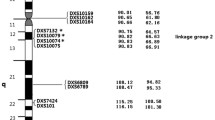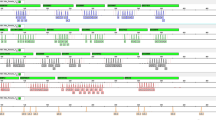Abstract
This study is to develop a new multiplex polymerase chain reaction (PCR) system that simultaneously amplifies the nine X-chromosome short tandem repeats loci in the same PCR reaction, and to explore their polymorphism and mutation rate among three nationality populations from China. These loci included DXS6854, DXS9902, DXS6809, GATA172D05, HPRTB, DXS7423, DXS6807, DXS8378, and DXS8377. The samples of 890 (484 males and 406 females) unrelated individuals from Guangdong Han population, Xinjiang Uigur, and Inner-Mongolia Mongol were successfully analyzed using this multiplex system. The allele frequencies and mutation rates of the nine loci were investigated, and the comparison of allele frequency distribution among different populations was performed. There were 87 alleles for all the loci, and six to 18 alleles for each locus observed by our new multiplex PCR system. Polymorphism information content was 0.4998–0.9101, and power of discrimination in females was 0.6518–0.9846. Five cases with mutation of above loci were detected in 5,310 meioses. Pair-wise comparisons of allele frequencies distribution showed significant differences for most loci among different populations. Our results indicate that this multiplex system is very useful for identification analysis, and that the information about polymorphism and mutation rate is necessary for forensic application in three nationality populations from China.

Similar content being viewed by others
References
Szibor R (2007) X-chromosomal markers: Past, present and future. Forensic Sci Int Genet 1:93–99
Liu QL, Lv DJ, Wu XL, Sun HY, Wu XY, Lu HL (2008) Development of a five ChX STRs loci typing system. Int J Legal Med 122(3):261–265
Tariq MA, Ullah O, Riazuddin SA, Riazuddin S (2008) Allele frequency distribution of 13 X-chromosomal STR loci in Pakistani population. Int J Legal Med 122(6):525–528
Turrina S, Atzei R, Filippini G, De Leo D (2007) Development and forensic validation of a new multiplex PCR assay with 12 X-chromosomal short tandem repeats. Forensic Sci Int Genet 1(2):201–204
Bekada A, Benhamamouch S, Boudjema A, Fodil M, Menegon S, Torre C, Robino C (2009) Analysis of 21 X-chromosomal STRs in an Algerian population sample. Int J Legal Med 124(4):287–294
Pico A, Castillo A, Vargas C, Amorim A, Gusmao L (2008) Genetic profile characterization and segregation analysis of 10 X-STRs in a sample from Santander, Colombia. Int J Legal Med 122(4):347–351
Poetsch M, El-Mostaqim D, Tschentscher F, Browne EN, Timmann C, Horstmann RD, von Wurmb-Schwark N (2009) Allele frequencies of 11 X-chromosomal loci in a population sample from Ghana. Int J Legal Med 123(1):81–83
Walsh PS, Metzger MD, Higuchi R (1991) Chelex 100 as a medium for simple extraction of DNA for PCR-based typing from forensic material. Biotechniques 10:506–513
Excoffier LGL, Schneider S (2005) Arlequin ver. 3.0: An integrated software package for population genetics data analysis. Evolutionary Bioinformatics Online 1:47–50
Botstein D, Skolnick M, Davis RW (1980) Construction of a genetic linkage map in man using restriction fragment length polymorphisms. Am J Hum Genet 32:324–331
Desmarais D et al (1998) Development of a highly polymorphic STR marker for identity testing purposes at the human androgen receptor gene (HUMARA). J Forensic Sci 43(5):1046–1049
Szibor R, Edelmann J, Hering S, Plate I, Wittig H, Roewer L, Wiegand P, Cali F, Romano V, Michael M (2003) Cell line DNA typing in forensic genetics—the necessity of reliable standards. Forensic Sci Int 138(1–3):37–43
Gomes I, Prinz M, Pereira R, Meyers C, Mikulasovich RS, Amorim A, Carracedo A, Gusmao L (2007) Genetic analysis of three US population groups using an X-chromosomal STR decaplex. Int J Legal Med 121(3):198–203
Mertens G, Gielis M, Mommers N, Mularoni A, Lamartine J, Heylen H, Muylle L, Vandenberghe A (1999) Mutation of the repeat number of the HPRTB locus and structure of rare intermediate alleles. Int J Legal Med 112(3):192–194
Szibor R, Edelmann J, Hering S, Gomes I, Gusmao L (2009) Nomenclature discrepancies in the HPRTB short tandem repeat. Int J Legal Med 123(2):185–186
Luo HB, Ye Y, Wang YY, Liang WB, Yun LB, Liao M, Yan J, Wu J, Li YB, Hou YP (2009) Characteristics of eight X-STR loci for forensic purposes in the Chinese population. Int J Legal Med. doi:10.1007/s00414-009-0386-z
Hwa HL, Chang YY, Lee JC, Yin HY, Chen YH, Tseng LH, Su YN, Ko TM (2009) Thirteen X-chromosomal short tandem repeat loci multiplex data from Taiwanese. Int J Legal Med 123(3):263–269
Edelman J, Hering S, Michael M, Lessig R, Deischel D, Meier-Sundhausen G, Roewer L, Plate I, Szibor R (2001) 16 X-chromosome STR loci frequency data from a German population. Forensic Sci Int 124(2–3):215–218
Asamura H, Sakai H, Ota M, Fukushima H (2006) Japanese population data for eight X-STR loci using two new quadruplex systems. Int J Legal Med 120(5):303–309
Aler M, Sanchez-Diz P, Gomes I, Gisbert M, Carracedo A, Amorim A, Gusmao L (2007) Genetic data of 10 X-STRs in a Spanish population sample. Forensic Sci Int 173(2–3):193–196
Pereira R, Gomes I, Amorim A, Gusmao L (2007) Genetic diversity of 10 X chromosome STRs in northern Portugal. Int J Legal Med 121(3):192–197
Tariq MA, Sabir MF, Riazuddin SA, Riazuddin S (2009) Haplotype analysis of two X-chromosome STR clusters in the Pakistani population. Int J Legal Med 123(1):85–87
Acknowledgements
This work was supported by national innovation experiment program for university students, China (091055856).
Author information
Authors and Affiliations
Corresponding author
Electronic supplementary materials
Below is the link to the electronic supplementary material.
ESM 1
(XLS 42 kb)
Rights and permissions
About this article
Cite this article
Liu, QL., Lu, DJ., Li, XG. et al. Development of the nine X-STR loci typing system and genetic analysis in three nationality populations from China. Int J Legal Med 125, 51–58 (2011). https://doi.org/10.1007/s00414-010-0520-y
Received:
Accepted:
Published:
Issue Date:
DOI: https://doi.org/10.1007/s00414-010-0520-y




